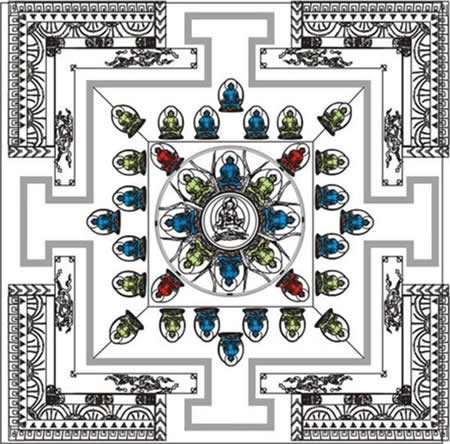Construction (cont'd.)
In the classical Tibetan Mandala, this cosmogenic process is often conceived of as a palace or fortress of sumptuous appearance and awesome dimensions and levels of defense. Not only is the Mandala literally a cosmic plan, but also a celestial palace. Such Mandalas are the 'homes' of the Diety. In one example it is the home of Durgatiparisodhana, an aspect of Vairocana, 'The Illuminator.'

The basic features of this Mandala are: the four portals or gates of the palace; and the inner lotus which is the bodhi-manda, the seat of the Diety. On the lotus petals and placed around the inner square are other figures embodying aspects of the Illuminating wisdom. As in Mandalas of this type, an outer protective circle symbolizes "a 'barrier of fire,' which at once prohibits access to the initiate and symbolizes th metaphysical knowledge that 'burns' ignorance."
"... as he approaches its center, the disciple approaches the 'center of the world.' In fact, as soon as he has entered the mandala, he is in a sacred space, outside of time; the gods have already 'descended'
... a series of meditations, for which the disciple has been prepared in advance, help him to find the gods in his own heart. Ina vision, he sees them all emerge and spring from his heart; they fill cosmic space, then are reabsorbed in him.
In other words, he 'realizes' the eternal process of the periodic creation and destruction of the worlds; and this allows him to enter into the rhythems of the cosmic great time and to understand its emptiness. He shatters the plane of samsara (cycle of rebirth) and enters a transcendent plane .." Mircea Eliade
source : Mandala, Jose' and Miriam Arguilles, Shambhala Publishing, Inc., Boulder, Colorado
image link:
http://translate.google.com/translate?hl=en&sl=es&u=http://www.lavozdelseptimoangel.com/&sa=X&oi=translate&resnum=1&ct=result&prev=/search%3Fq%3Dhttp://www.lavozdelseptimoangel.com%26hl%3Den%26client%3Dfirefox-a%26rls%3Dorg.mozilla:en-US fficial%26hs%3DIFK
fficial%26hs%3DIFK